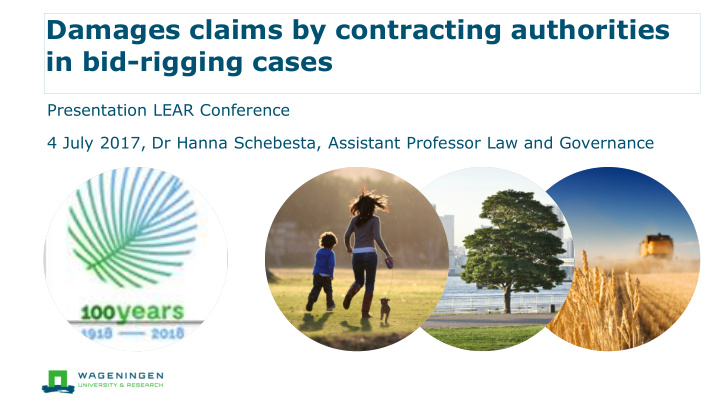



Damages claims by contracting authorities in bid-rigging cases Presentation LEAR Conference 4 July 2017, Dr Hanna Schebesta, Assistant Professor Law and Governance
PP and Antitrust linkage high on the agenda Guidelines for detecting bid-rigging by almost all competition authorities globally and international efforts (OECD roundtable) Main recommendation: procurers should report suspicions and collected evidence to the competent competition authority Little attention to damages claims by procurers 2
Complementarity of remedies Exclusion from the tendering procedure (Article 57(4)d Directive 2014/24) for distortion of competition Criminal sanctions ● E.g. § 298 German Criminal Code: monetary sanction or prison sentence of up to 5 years Fines ... Damages actions? Settlements 3
What can damages claims deliver that sanctions/fines cannot? 4
Why enable damages claims? The function of damages Punishing the offender (retributive) Preventing future offenses (preventive) Sanctions/fines equally effective Repairing damage sustained (compensatory) Damages claims have more immediate compensatory effects 5
Damages claims by contracting authorities in Germany New legal framework (Amendments to the Antitrust Act) Few cases of successful claims by contracting authorities and cartels 6
New provision § 33a GWB Antitrust Act (DE) entry into force June 2017 Intentional or negligent infringements of Articles 101 and 102 TFEU create a duty to compensate the resulting harm ; § 33a(1) There is a rebuttable presumption that a cartel causes damage; § 33a(2) ● but recognition of passing-on defence ; § 33c The quantification of damages according to § 287 of the Civil Procedure Ordinance; § 33a(3) Limitation period of 5 years § 33h from knowledge 7
Proving damages is a twofold challenge • Prove that damage was sustained (principally/as a substantive or material criterion for giving rise to Constitutive a successful cause of action) stage • Quantify the damage sustained (quantification) Quantification stage 8
Fire-fighting vehicle cartel Vehicles procurement procedure (value 120.163,24 EUR) Cartel of four biggest producers 9
Issue 1: presumption of damage? OLG Karlsruhe Urt. v. 31.7.2013 Court: price-fixing in tender created presumption of damage ● General presumption that cartels result in surcharges ● Recognized pricing umbrella effect New §33a and 33c supersede this case law Legal uncertainty: ● Relevance of the passing on defence? ● Evidentiary burden (diverging case law) 10
Issue 2: advantage of liquidated damages? OLG Karlsruhe Urt. v. 31.7.2013 Liquidated damages, contract contained the clause that when the contractor violated competition rules, 15% of the billing sum would be due In this case, 15% of 120.163,24 € Clause made quantification of damages easy Divergent case law as to the general validity of the clauses: Rail Cartel and Fire-fighting vehicle II: non-validity as no general price increase may be assumed 11
Link between cause of action and claimable damage Damages claims arise out of specific causes of action Contract clauses – contractual damages (e.g. liquidated damages in German fire-fighting vehicles case) Competition law damages More specific legal frameworks (e.g. in the US the False Claims Act; allowed for treble damages over $103 million in a sewer construction case) Culpa in contrahendo/pre-contractual liability? 12
Can damages deliver? Generally there are only few, although successful cases; policy documents (OECD) indicate reluctance of government agencies to pursue damages claims Legal uncertainty persists as to proving the damage Doubtful validity of contractual clauses Litigation costs Depends on the case, but systematically strengthening the institutional framework seems more effective in terms of enforcement 13
Recommend
More recommend